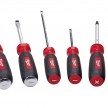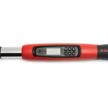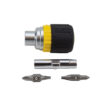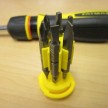Gearwrench Screwdrivers
Gearwrench Screwdrivers
Gearwrench screwdrivers aren’t as well-known as their wrenches, but all of their tools are well-regarded by the vehicle mechanics that constitute its traditional market. Tools, including screwdrivers, intended for the engine and equipment repair have to be extra tough. Not only are they used as makeshift prybars and levers, but they are almost always working on rusted or corroded fasteners. In addition, they are constantly exposed to (or drenched in) corrosive chemicals and generally all manner of unpleasant schmutz.
Gearwrench recently came out with a whole new line of screwdrivers, sporting orange and black handles. This isn’t an overview or review of the entire new Gearwrench screwdriver line, which is extensive. Instead, I describe what makes the new Gearwrench screwdrivers good. Second, I give examples from the new line of a few screwdrivers and drives that you may not have on hand but probably will wish you had one day.
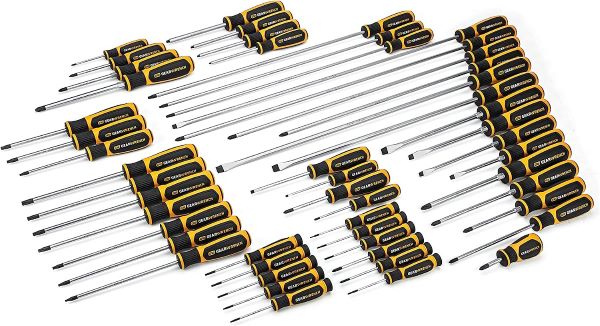
Basic Specs for Most New Gearwrench Screwdrivers
- Ergonomic tri-lobe dual material handle provides the optimal balance of strength and efficiency
- “Speed Zone” handle design for faster rotation in low-torque applications
- Dual material handle offers a more comfortable grip and higher performance
- Non-Slip black oxide tip for more secure fit in fastener
- Blades laser etched with part number and size for quick identification
- Oil and solvent resistant handle provides a longer tool life
- Full polish alloy steel screwdriver shaft prevents rust and corrosion
- Meets or exceeds ASME standards for performance and quality
Gearwrench Screwdrivers – A Modern Design
In the days before World War II screwdrivers were mostly made with wood handles. Of course, these handles absorbed chemicals and often cracked. Nonetheless, some survived – I have one that I still use that was handed down to my dad and then to me. After WWII acetate handles ruled for decades, usually round in cross-section with lengthwise valleys. I grew up with these screwdrivers but found them too hard and never comfortable in my hand. However, obviously, many tradespeople do like them since they are still made to this day.
The new generation of screwdrivers — on the market for the last couple of decades — feature oil-resistant dual-material handles, usually a hard polymer with a slightly tacky (hard rubber-like) material inset into it. Gearwrench screwdrivers are of this design, and it works very, very well. The handle is just slightly tacky enough in your hand for high torque turning, yet firm enough to be secure and provide good tactile feedback.
Modern designs often have a more-or-less rounded-over triangular cross-sectional shape, what Gearwrench calls a “tri-lobe” shape. This handle shape is very close to perfect. The trick with a screwdriver handle is to have the shape dig into your hands when you’re squeezing it hard in a high-torque turn but rotate easily in your hand when you’re spinning low-resistance fasteners. This shape, combined with the dual-material handles, does it all.
Gearwrench takes it a step further. They incorporate a band of hard rubber-like material at the bottom of the handle, calling this the “speed zone”. This allows you to hold the screwdriver in one hand and spin it with the first three fingers of that hand, while alternately spinning it with the thumb and forefinger of the other hand (see photo below). That’s a welcome feature.

The size of these screwdrivers is right, too. According to all the data I’ve seen, I have average size hands for an American male, and Gearwrench screwdrivers fit my hand well. I’ve tried some very highly-regarded European screwdrivers, but they are too small for my average-sized hands.
The tip of most of the new Gearwrench screwdrivers is black oxide conversion coated, which adds texture and thus friction to the tip when it’s in the fastener drive. The beefier screwdrivers also have a hex-shaped bolster, so you can turn the screwdriver with a wrench if you need the extra torque.
The only thing that I wish Gearwrench could have done better with this new line is to more clearly identify the drive of each screwdriver driver on its end cap. There is a graphic on the end cap in the shape of the drive, but no size is denoted. And while the drive size is laser etched into the shaft, this isn’t easy to see.
A History Aside
Indulge me for two short paragraphs while I explain why that ordinary screwdriver in your hand, that you take for granted, represents a giant leap forward in human progress. (In fact, a whole book, One Good Turn, has been written on this subject.)
Progress on an industrial scale requires machines. It’s not possible to produce machines on any large scale, or of any significant complexity, without fasteners incorporating standardized threads. It was the development of standardized threads, and the means to produce them on a large scale, that led to a quantum leap in the ability to produce machines of all sorts. The leader in thread cutting technology and production was centered in Western Massachusetts in the early 20th century, and it’s no exaggeration to say that it was the Silicon Valley of its day. There’s a nice grass-roots museum of the history of thread-cutting technology at The Museum of Our Industrial Heritage in Greenfield, Massachusetts – it’s worth a visit!
Gearwrench Specialty Screwdrivers for Unusual Drives
Gearwrench makes screwdrivers in other drives than the usual Phillips and slot. Here’s a few of them, and my opinion as to why you should include each in your kit.
3/16 x 6-inch Cabinet Tip Slot Screwdriver
First up is the Gearwrench 3/16 x 6-inch cabinet tip slot screwdriver ($8 at Amazon). I know you’re asking yourself, “What’s so unusual about this?” Well, a couple of things — all derived from the fact that this is the quintessential electrician’s screwdriver. I literally grew up with one of these in my hand.
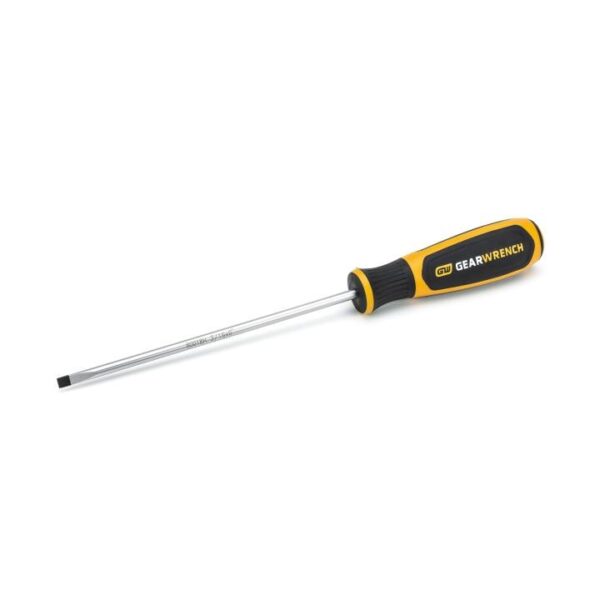
This is a narrower screwdriver than many carpenters or woodworkers, and certainly most mechanics, need very often. But the 3/16-inch tip, made even narrower by its cabinet (rather than a keystone) shape, is the preferred slot driver for the small 6/32 screws that are so common in electrical fixtures. Literally, every electrician has one of these screwdrivers in their pouch all the time. If you do any electrical work at all, you’ll find a screwdriver with a 3/16-inch cabinet tip a professional upgrade to whatever else you might be using.
The 6-inch shaft is my preferred length. Electricians are probably split as to their preference for a 4- or 6-inch shaft on their screwdrivers; I’ll take a 6-inch shaft if I have a choice. There are two reasons for this. First, electricians are often – even usually – working with screws that are inside some sort of fixture or box. Second, assuming that your hand will naturally waver as you work, basic geometry dictates that a longer shaft translates to less movement at the screw head.
So why not go to an even longer shaft? Because they get unwieldy. Six inches is the sweet spot for me, although I’m also fine with 4-inches.
Gearwrench #1 and #2 Square Drive x 4-inch Screwdrivers
Gearwrench’s #1 and #2 square drive x 4-inch Screwdrivers (here and here) cost only about $7 at Amazon. At that price, you should pick them up, even if you haven’t encountered square drive fasteners in your work…yet. Because you will eventually, and there’s no good way to turn them without a square drive driver. Square drive screws are starting to turn up everywhere.
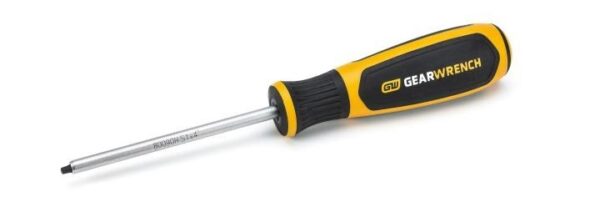
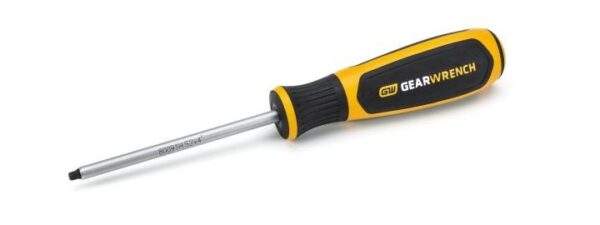
The square drive is gaining in popularity because it is so superior to the ubiquitous Phillips drive. As most of you know, the Phillips drive was actually designed to cam out under high torque, and boy does it! The only reason that the square drive didn’t take off instead of the Phillips is because Henry Ford couldn’t license the drive from its inventor, the Canadian Peter Robertson, and he went to the Phillips drive instead. (There’s a fascinating history there if you want to look into it.)
Now yes, there’s a bit of a difference between a true Robertson drive and a square drive, but the square drive is what’s most common in the United States (Robertson is more popular in Canada). But unless you’re dealing with a very tightly torqued-down fastener, they are, for most practical purposes, interchangeable.
Better to have these square drive screwdrivers in your truck or shop before you discover that you need them…and don’t really have a good alternative. Also, a square drive screwdriver will sometimes turn a stripped Phillips cavity.
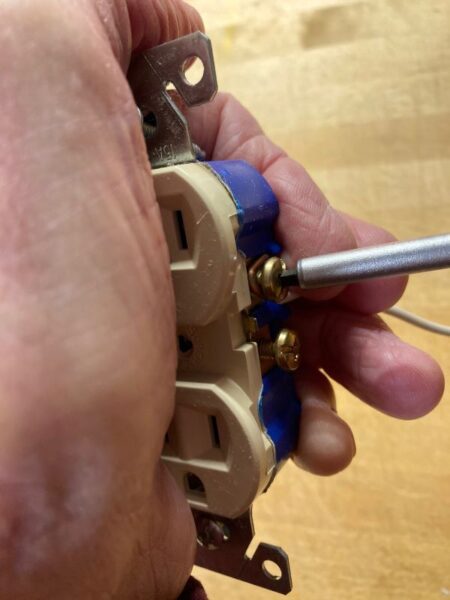
Gearwrench Pozidriv® Screwdrivers
The Pozidriv drive is one of several Phillips-like (cruciform) drives on the market. You may have heard of Fearsondrives (although I’ve never run into them) and JIS (Japanese Industrial Standard (you’ll want screwdrivers for JIS screws if you work on older Japanese motorcycles or cars). There are others, too, but the one other cruciform drive you’re most likely to encounter is Pozidriv. To simplify: Pozidriv is like Phillips with the addition of an additional smaller cruciform shape set at 45 degrees to the main one. Phillips screwdrivers will work, but badly, in Pozidriv screws (while the reverse isn’t true). Pozidriv screws are found mostly in European items such as furniture and cars, but if you work with European cabinets or hardware, you may very well run into them.
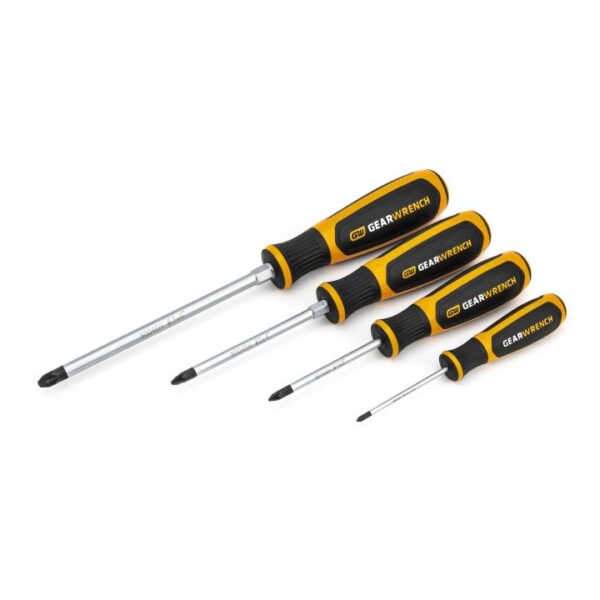
If you try and use a Phillips screwdriver on a Pozidriv screw you will either strip the screw head or not be able to tighten the screw sufficiently, or both. Given that so many European items are showing up routinely in American houses, factories, offices, and so on, having a proper set of Pozidriv screwdrivers in your bag o’ tricks is a good idea.
Gearwrench sells a 4-PoziDriv screwdriver kit for $33 at Amazon. That’s only $9 a screwdriver. If you do any automotive or remodeling work, you can save yourself some serious regrets by having this set handy. Your tax advisor is probably telling you to set aside some money each year to buy new (not just replacement) tools; this set would make an excellent, low-cost item in that category.
What, no Torx?
Actually, the new Gearwrench screwdriver line does include Torx screwdrivers – lots of them. Further, most people agree that Torx is heads and shoulders above almost any other fastener drive. I haven’t included Torx screwdrivers in this little list though, because while Torx screws are common in the trades, they are mostly driven with an impact driver. It’s far less common to run into a situation where you’ll want a Torx screwdriver…at least yet. Of course, the world may get more rational and that might change — we can hope! (On the other hand, the United States still hasn’t changed over to the vastly superior metric system.)
A Good Investment
Screwdrivers aren’t expensive, so laying in the unusual drives that you will, or have a good chance of, encountering is a smart thing to do. You don’t want a project to come to a halt for lack of the right tool. This advice applies to all trade types, from DIYer to pro. Gearwrench screwdrivers, with their effective, comfortable modern design are a great choice for covering your bets here.




